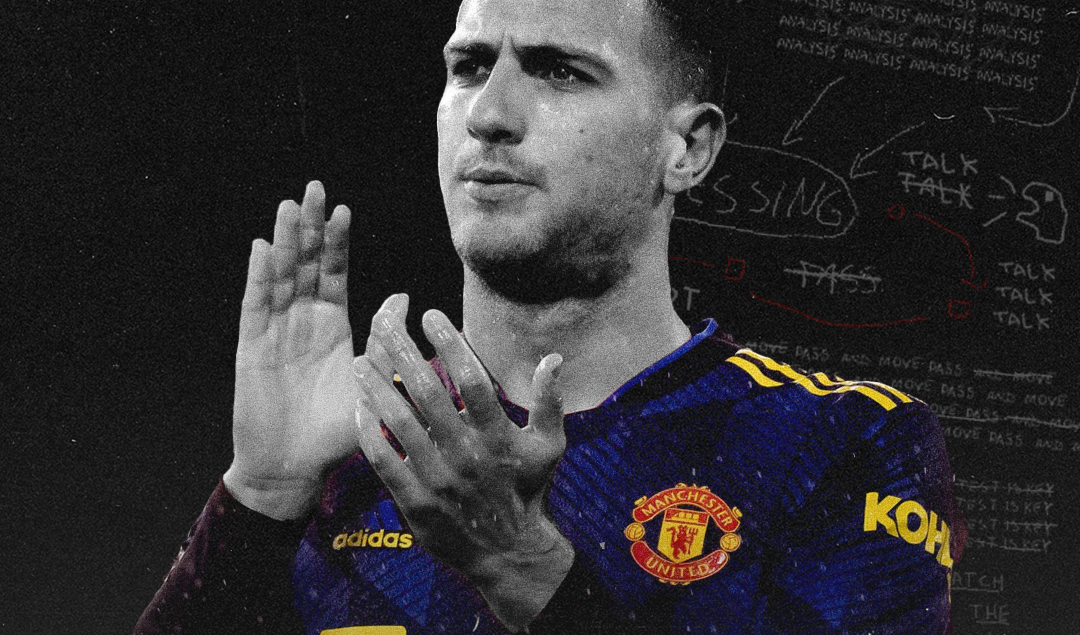Manchester United’s Woes From Set-piece Situations
Manchester United entered February in ninth place after a chaotic start to the campaign both in terms of gaining points and quality of play, but today, they find themselves sixth in the table, five points behind Aston Villa and six behind Tottenham. Erik ten Hag’s team is very dependent on the match scenario – against opponents with well-established, aggressive pressure, United is experiencing difficulties in the build-up phase due to the absence of Lisandro Martinez, and against deep-block opponents, they cannot create anything in a positional attack.
United’s numbers are terrifying. In terms of xG created from open-play, the team is in the middle of the table, and its mediocre attacking numbers are spoiled even more by the finishing of the strikers – United scored only 18 goals, only three teams from the bottom of the EPL less. Good quality set pieces could have corrected the situation, but here United are showing themselves even worse, both in offensive and defensive ways.
Only Sheffield United creates fewer than Erik ten Hag’s side from set-pieces, and in terms of shots against and xG allowed, United is in the worst five of the Premier League. This text is an attempt to identify and comprehend the problems of Manchester United on the corners, to find growth points that would allow progress in this component of the game.
Research Methodology
For analysis, 157 corners in attack and 164 corners in defense were taken from the matches of the current season in the Premier League and UCL – 4 offensive corners from the match against Sheffield United were not included in the list due to the absence in the Wyscout portal.
Each corner was assigned a number of parameters: attacking and defending team, minute, score at the time of the corner, the corner taker and the shooter, the result of the kick and its xG, the side of the corner, the type of draw and serve, the serving area, the number of attacking players in the penalty area/second ball zone/short draw zone, defensive system, number of defensive players in the penalty area/second ball zone/the short draw zone/the central circle zone, the presence of a second ball shot and the presence of a counterattack.
The first 9 parameters are intuitive, they were calculated automatically, for which thanks to my friends from xglab. Now I will explain the remaining parameters for a better understanding of the calculation methodology.
The type of draw: a direct cross into the penalty area, a short pass, a prepared draw and a time-killer. A short pass draw is a pass to a player standing near the corner taker to create a 2v1 or 2v2 situation at the corner of the field. An example of a prepared draw is a cross to Bruno Fernandes in a second ball zone for a volley against Nottingham Forest or a pass into the penalty area to a player running out of it, followed by a low-pass combination. I classified the prepared corners with blocks into the category of delivery.
Analyzing Manchester United’s Start to the 2023/24 Season Under Erik ten Hag
Time killer – corners at the end of the match, played short in order to kill the time. Type of delivery: incoming and outgoing, depending on the spin of the ball. Cross area: near post, center of the penalty area, far post, penalty spot area. This parameter is relevant only for corners with a direct cross into the penalty area. Number of attack and defense players: The number of players in the zones shown in the picture below.
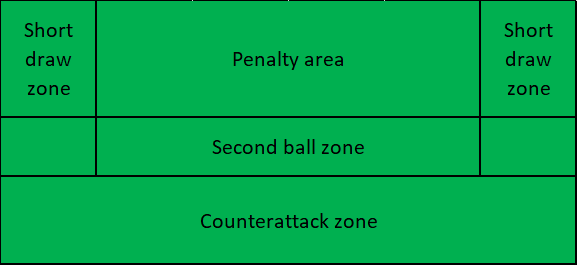
Defensive system: mixed, personal, zone, “Sparta”. In a mixed defensive system, the team is divided into two groups – the first usually consists of 4-5 players located in a line on the border of the goalkeeper area, another 3-4 players are located slightly higher and play against their opponents personally, the rest of the team’s players are located in the second ball/short draw area.
With individual defense, many 1v1 duels are created inside the penalty area, when playing zonal, the team lines up in two lines, usually 4-5 people each, each player is assigned to his zone, and in case of an opponent’s breakthrough, passes it to his partner. Sparta is a draw when the attacking team overloads the goalkeeper area as much as possible, where a cluster of players prevents the goalkeeper from claiming the cross.
Most often in such situations, the serve curves to the near post, where the attacking player runs and makes a light touch to slightly change the ball’s further direction, counting on chaos in the goalkeeper area, a lucky deflection. The presence of a second ball shot and a counterattack: binary parameters, in the case of a second ball shot/a counterattack, the indicator “Yes” was set, in the absence of an indicator “No”.
Offensive Corners
The main corner taker in the team is Bruno Fernandes. The Portuguese went to the corner flag 98 times, almost twice as many as all the other takers combined. The United captain is able to execute any type of serve – a sharply curved one at the near post, a high trajectory one, a pass into the second ball zone – but despite this, compared to their rivals, United uses direct crosses less often, 77% of corners against 82% played this way.
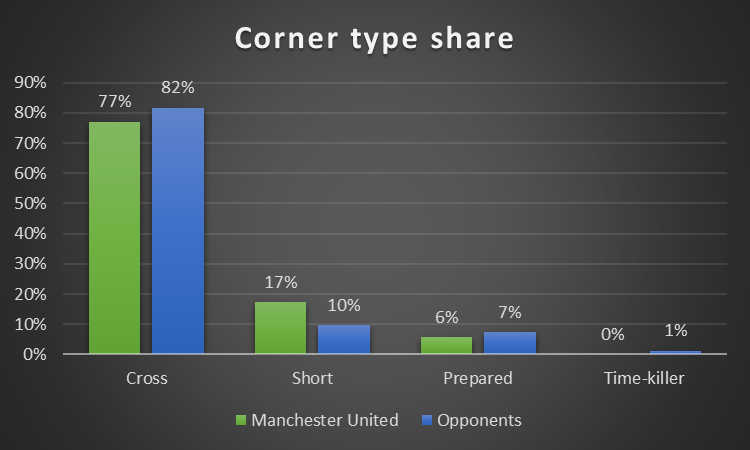
In my opinion, the reason is the desire of the players to create a more chaotic situation in the penalty area, because short draws provoke more uncertainty. Fernandes, who constantly scans the field in search of an opportunity to sharpen the game, often plays the ball without waiting for the penalty area to be filled if he sees vulnerability in the opponent’s defense, which affects the final ratio of direct crosses/short draws.
The distribution of the ball delivery zones is as follows: most of the serves (40%) fly to the near post, a run of a United player into this zone from the center of the goalkeeper or from the penalty spot area is one of the few regular actions with corners in attack. A little less (36%) is performed in the center of the goalie box, where a tall central midfielder and Rasmus Hojlund/one of the two CB are often located, plus it is the zone that players starting from the penalty spot usually make their runs.
After the first round in EPL, United stopped filling the far post zone with a player at all, which is why only 8% of the deliveries are directed to this zone. The remaining 16% are given to crosses in the penalty spot zone, most often these are outgoing crosses from the right flank.
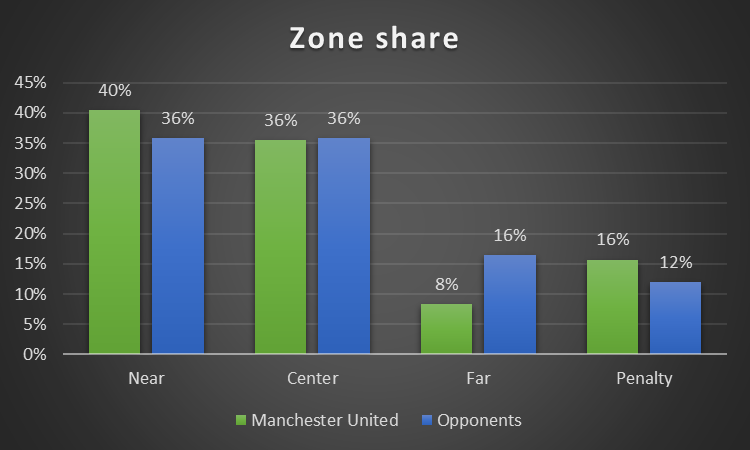
The proportion of in-swingers and out-swingers is another difference between Ten Hag’s team and their rivals in the Premier League. In 59% of cases, the cross of a United player goes away from the goal, while for opponents this figure is only 43%.
Indirectly, this is due to Luke Shaw, the Englishman is the only left-footer with a good cross in the team, but due to the high injury proneness and frequent absence from the field, all corners on the right have to be performed by right-footers (Bruno Fernandes, Christian Eriksen, Mason Mount), so almost all the serves are out-swing. Without a left-footed taker, the team becomes more limited, for example, it cannot perform the “Sparta” draw, which involves a sharp cross to the near post, with corners on the right.
The main corner formations in attack for United are 5-3-1 and 5-2-1, where the first number stands for penalty area players, second for second ball zone players, and the last one for the short draw players. The five players in the opponent’s penalty area are usually distributed as follows – Hojlund is either located next to the opponent’s goalkeeper, preventing him from claiming the ball, or in the center of the goalie box, from where he makes a run to the near post.
Could the Erik ten Hag Era Be Nearing a Premature End at Manchester United?
A pair of central defenders usually starts their movement from the penalty spot, making a run either to the near post or to the center of the penalty area, where the tall central midfielder / Diogo Dalot has been since the beginning of the episode. In an alternative situation, the entire three players immediately begin the episode at the penalty spot.
The far post remains empty, but on the far edge of the penalty area, closer to its horizontal border, there is almost always a winger, ineffective in the aerials. The ball rarely reaches him, the player could be easily classified as a second ball zone player, which makes the arrangement even more bland and less dangerous.
In the case of the 5-3-1 formation, one of the three second ballers are located in the corner of the penalty area closest to the ball, and can situationally join the partners in case of a short draw. The remaining two players are waiting for the rebound in the area in front of the penalty box, most often the fullback and the central midfielder are located there. With a 5-2-1, everything remains exactly the same, except for the player at the corner of the penalty area.
Next to the corner taker is usually the winger closest to the corner of the pitch, or Eriksen. Short draws most often end with a delayed delivery, but occasionally United players get into the penalty area through a pass or there is a shot after cutting in the middle by carry.
As a result, Ten Hag’s team gets a situation where two of the five players in the penalty area – Hojlund, who often stands next to the goalkeeper, and the winger on the far edge of the penalty area – rarely take a direct part in the episode. Such a shy setup, where three, maximum four players pose a direct threat to the opponent’s goal, and the rest are aimed at deterring a potential counterattack in case of loss, the team began to use after a bad performance in transitions at the beginning of the season against Wolves and Forest.
In addition to the shy formation, the disappointing results of Eric Ramsey’s work – United’s set-piece coach – is the almost complete lack of prepared combinations. Ten Hag’s team very rarely uses blocks, players do not clear space for a partner with false runs. The movement of United players in the penalty area resembles chaos, it looks spontaneous, very uncoordinated. During the season, there were only two variants of the draw, where training can be traced.
The first, extremely simple, is to cross into zone 14 or to the far edge of the penalty area for a volley. In the away match with Forest, Ten Hag’s team used this draw three times. In the middle of the second half, Alejandro Garnacho hit without resistance (partners blocked opponents) from the far post area, and in the last few minutes, Fernandes struck twice after Eriksen’s cross into zone 14 – the first shot ended with a great save by Matt Turner, the second with a potential penalty against the hosts.
The second one is not so much a specific draw as a detail of the global process of preparing for the match under Ten Hag – preparations for specific opponents. For example, in a home match against Galatasaray, who uses zonal defense, United played half of their corners short. By playing it short, Ten Hag’s team pulled one or two opponents out of the penalty area, thereby destroying the Turks’ well-established defensive system, creating more chaos.
And in home games with Brentford and Chelsea, the Sparta draw option was regularly used, when all attacking players fill the opponent’s goalie box in the expectation of a successful deflection in a crowd of players – a good strategy against, for example, Sanchez timidly playing on the exits. Of the 18 such draws in the half of the season, 13 came in these two games.
Areas for Improvement in Attack
In my opinion, United’s corners have two aspects that need improvement. The first is the optimization of the starting line–up of players. United’s corners are very different from the opponents’ corners, they practically do not use the 5-3-1 formation favored by Ten Hag and Ramsey, preferring 6-2-0 and 6-1-1. There problem is not so much about the formation as about its inefficient usage in three specific cases.
First, Hojlund’s positioning. The Dane is often positioned next to the opponent’s goalkeeper, preventing him from claiming the cross. The problem is that United do not adjust the corners to the actions of their striker. Is it that necessary to limit the opponent’s goalkeeper if it doesn’t matter to you whether he goes out or not? Perhaps it is worth placing Hojlund in a group of attackers from deep, where he can show his good movement in the penalty area?
Secondly, there is an excessive number of players in the second ball area. Yes, United often collect rebounds from the penalty area, but rarely end it with a second-tempo strike. Yes, United are great at stopping the opponent’s counterattacks at their start, but is it so profitable from the point of risk/reward to leave three players in this zone for fear of a potential counterattack, instead of sending one of them to the penalty area, where he can, for example, distract Harry Maguire’s/ Raphael Varane’s man-marker with a false run, or put a block on him and clear space for his central defender? The issue is debatable.
Thirdly, the use of an additional player for a short draw. United rarely leaves the corner taker alone, and play short more often than the opponents. But this does not bring the team practically any benefit – only four shots were made from 36 attempts, the total weight of which is 0.07 xG. Is there a need for unprocessed, spontaneous combinations, without a well-thought-out plan?
The second aspect that needs improvement is the development of prepared combinations with blocks and false runs. Eric Ramsey’s arrival at the club three years ago was presented as a great success, but since then United have never scored more than 11 xG from set pieces in one Premier League season, and scored a maximum of 7 goals. For example, Everton had almost 10 xG created and 11 goals scored at the beginning of February.
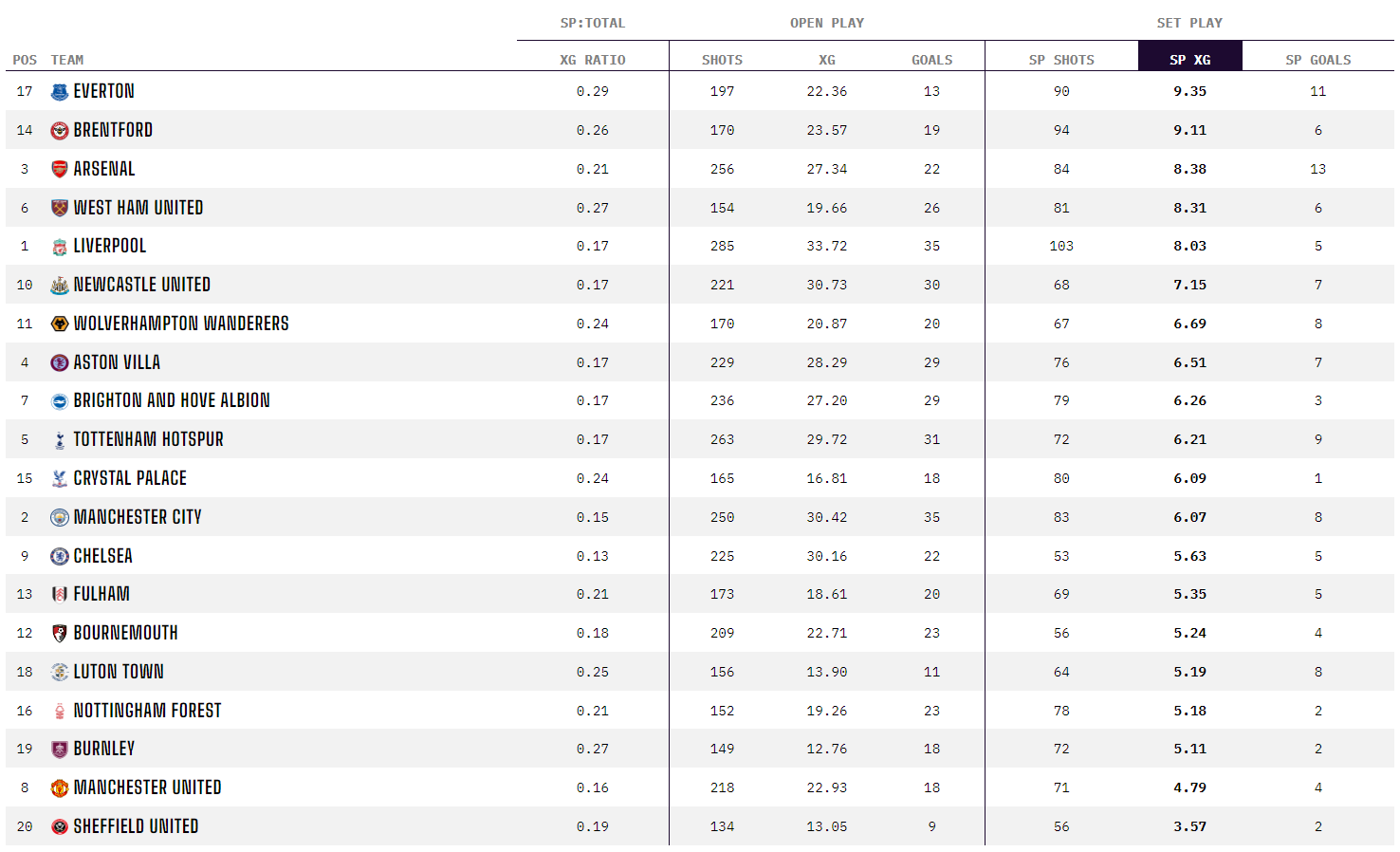
Ramsey is struggling for results so far: United have almost completely no combinations of corners worked out in advance at the training ground, and the team is the penultimate in the Premier League in terms of the amount of xG created from set pieces. To understand the importance of a set piece coach, there is another example of Nicolas Jove from Arsenal – this season the Londoners scored 12 goals after set pieces, only six fewer than Ten Hag’s team from open-play.
Defending Corners
United uses a mixed type of defense. Inside the penalty area, the team is divided into three groups – the first consists of five people located on the borders of the goalie box, in the second group, located slightly higher, four players personally mark their opponents, the third consists of one person collecting a rebound in the second ball zone, or controlling a short draw.
Most of the opponents’ corners are aimed at the near post, so United puts two players in this area for more control. Together with Bruno Fernandes, someone from the three of Scott McTominay, Marcus Rashford, and Rasmus Hojlund regularly turns up here. Crosses to the far post are rarely executed, so United almost always have only Diogo Dalot there.
However, it is after serving into the Portuguese’s zone that the opponents create the most threats – the destruction from Arsenal remains in memory, where, in addition to Declan Rice’s goal, the Londoners struck two more shots from the far post, Bayern’s penalty, Leander Dendoncker’s goal in the match with Villa and Timo Werner’s dangerous strike in the January match with Spurs. Of the six strikes weighing more than 0.1 xG made after corners, half were struck from the far post.
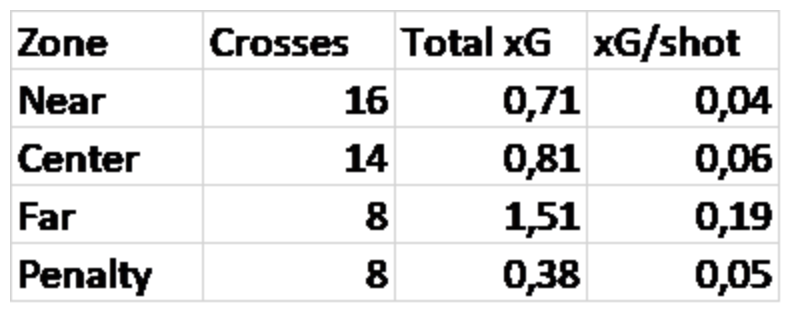
The CBs are responsible for the defense of the goalie box in the Ten Hag’s team. In this zone, the Dutchman, along with Eric Ramsey, want to see tall, strong defensive players – central defenders are often helped by McTominay or Casemiro – who, due to their choice of position and physical strength, can win an aerial even against well-jumping opponents, level their dynamic advantage.
An additional argument is their low agility and mobility – it is much easier for a bulky Maguire to defend from static than to play a 1v1 against a sharp opponent who constantly makes multidirectional movements and false runs. In this regard, Lisandro Martinez differs from his partners. He compensates for his low height with an excellent jump, great agility and reaction speed to the episode, so he is entrusted with various tasks – the Argentine is the only central defender on the team who defended in all possible penalty areas (near, center, far, penalty).
A group of players defending personally is formed according to the residual principle. There are two main options for filling it, depending on the presence of Scott McTominay on the field. In the first variant, the group consists of Hojlund, a winger, a short central midfielder and a fullback. This arrangement is used when there is a Scot on the field, who covers the near post, and sends Hojlund to defend personally. In the second case, the group consists of two low central midfielders – there is no McTominay on the field – a fullback and someone from the Rashford/Hojlund pair.
In both cases, the main vulnerability is the Dane. Due to the minimal marking skill, opponents often easily left him behind, going out for a shot without any resistance. In addition, despite his height, Hojlund does not show himself in the best way in horseback riding. He jumps out weakly, and does not always choose the right moment to do it.
The second winger, usually Garnacho, is responsible for the second ball area and control of the short draw. The location of the Argentinian in these zones is as justified as possible – in the aerials against high opponents he will be useless, 1v1 he will be destroyed even easier than Hojlund. But in the case of a collecting a second ball, the Argentine’s speed will be very useful, thanks to which he can organize a quick counterattack.
Periodically, the 5-4-1 formation makes life tougher for Garnacho. When opponents play a corner short, the Argentinian does not always have a partner coming from the penalty area, which creates a 1v2 situation on the flank, and when playing against an in-swinger, United has a habit of falling too deep into the penalty area, which increases the area that Garnacho must control, gives more freedom to opponents.
United, like their rivals, do not use a player located in the center of the field for potential counterattacks, which looks logical – for 321 analyzed corners, the defending team only ran into a counterattack four times.
Areas for Development in Defense
The weaknesses in United’s defensive corners are divided into personal and systemical ones. In addition to Hojlund, whose problems are described above, Kobbie Mainoo is a personal vulnerability. The young Englishman is easily pushed through because of his small size, and the lack of experience at the professional level does not allow him to play by choosing a position.
Theoretically, a position in the rebound zone would suit Mainoo, from where he can disperse a counterattack with a pass – he could easily perform a very difficult pass, and has no problems with the speed of decision-making. The question is, is the already poorly defending United ready to reduce the number of players in the penalty area? And does it even make sense?
The systemic problems of the Ten Hag’s team are the control of the far post (described in the previous section), and defense against Sparta type corner kicks. The opponents are blocking Andre Onana well, pushing through the United players. Three of the four goals conceded came as a result of such a Sparta type corner.
Manchester United began February with an instant classic at Molineux, prevailing 4-3 against Wolves courtesy of Mainoo’s 97th-minute winner, before thrashing West Ham 3-0 via Hojlund’s opener and a second-half brace from Garnacho. The Dane opened the scoring early on, becoming the youngest player to score in five straight Premier League matches since Nicolas Anelka in 1998. Douglas Luiz drew Villa level in the second half, but the Red Devils had the last laugh as Scott McTominay continued his late goal-scoring heroics and secured the three points. They’ll be looking to continue their impressive form on Sunday as they travel to Luton Town.
By: Nick Bobrov / @normalnik131
Featured Image: @GabFoligno / Ash Donelon / Man United
